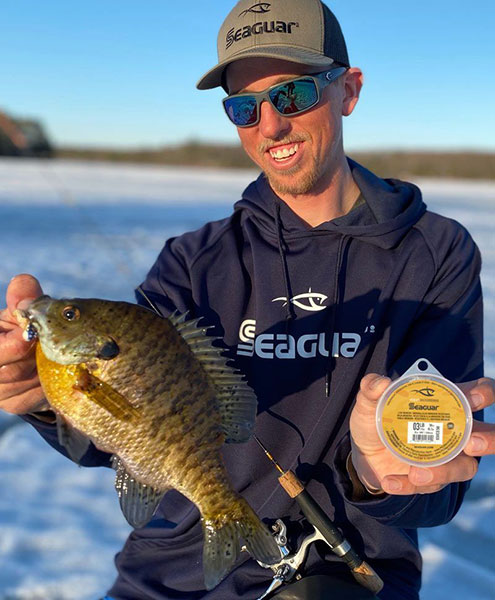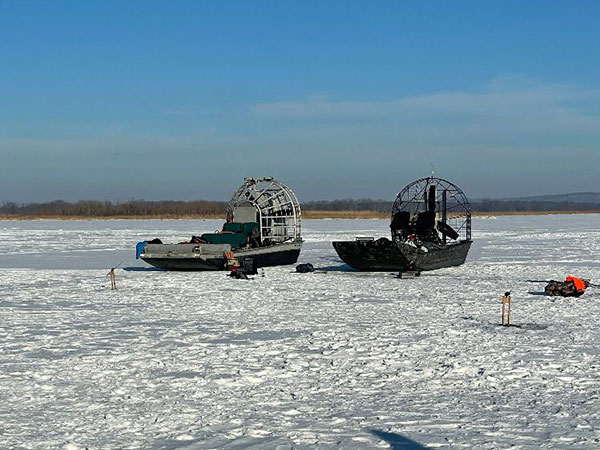Seaguar Report
 Josh Teigen with yellow perch
Josh Teigen with yellow perch
If it's going to be cold out, it might as well be cold enough to freeze the lakes and rivers. Right now, ice fishing season is quickly approaching in many regions and one of the best ways to get in on the action is by targeting first ice panfish.
A trio of Wisconsin guides, Troy Peterson, Vince Moldenhauer, and Josh Teigen, all count early ice panfish as one of their favorite bites, and each has a unique approach to fishing this time of year. They each share their thought processes and methods for early-season ice fishing
Mr. Bluegill's Ultra-Shallow Bite
 Josh Teigen with bluegill
Josh Teigen with bluegill
Troy Peterson is known as "Mr. Bluegill," and he guides anglers for them, along with many other species, throughout the year. As soon as the ice forms on the lake, his approach is to stick close to shore and search for vegetation and warmer water.
"Right when the ice forms, everyone is itching to get out and you have to be quick," he said. "The first two weeks of the season can be excellent, but the fish get pressured and areas get fished out. I look for weedy bays and houses on the lake that have pumps or artesian aquifers because that will show you that warmer water is coming into the area. The panfish will stay in the areas as long as possible until it gets too cold and they will head out deeper."
Typically, Peterson targets panfish in depths of 3 to 5 feet of water early in the ice season and he says that necessitates a stealthy approach.
"The first thing we do is drill a bunch of holes," he said. "That way, we can fish one and then quietly walk to fish the next one. We also use longer rods, 4 to 5 feet long, so you can fish one, turn slightly, and drop into another hole without making much noise. The water and ice are clear and there isn't usually a lot of snow on the ice, so you have to be very stealthy."
To catch his early ice panfish, Peterson primarily uses 3 or 4-mm tungsten jigs matched with small plastics such as the Eurotackle EPM Minnow or Micro Finesse Stone Fly, both just a little longer than an inch.
With these finesse offerings, Peterson prefers a light fluorocarbon line. "2 lb. IceX is what I use for all of my panfish," he said. "It has a very thin diameter and with small plastics – you get more action with a thin and supple line. It also has good knot strength. I've even landed pike on that line."
Teigen's Approaches Based on Water Clarity
Depending on if he is fishing a clear or stained body of water, Iron River, Wisconsin guide Josh Teigen adjusts his areas when targeting perch, bluegill, and crappie through the ice.
"On stained lakes, the best fishing for us is on the main basins of the lake," he said. "Many times, they'll be deep and suspended 5 to 7 feet off the bottom. It's best to drill a bunch of holes, keep it moving and use your electronics to find the groups."
Teigen also uses sound to his advantage when targeting stained water panfish and chooses noisy lures. "We like to use louder baits to call the fish in," he said. "One of the best is a 1/12-ounce ACME Rattle Master spoon or Acme Google Eye Tungsten Jig, both tipped with a wax worm or two."
For cleaner water, Teigen seeks out vegetation. "On many clear lakes, the weeds will stay green all winter," he shared. "I look for the cabbage or sand grass that ends around 18 to 22 feet of water and will fish the same baits. On the clear water lakes, the morning and evening bite seems to be the best and it's more of a midday bite on the stained bodies of water."
Teigen prefers Seaguar IceX fluorocarbon line for both lake types, primarily the 3 lb. test.
"I prefer to use straight fluorocarbon for panfish and you can feel the bite very easily," he said. "IceX is very durable and has a tiny bit of stretch, which is good for crappie because they have such soft lips. The invisibility is also key because the fish in clear water can get line-shy sometimes."
Moldenhauer Airboats to the Ice
 Vince Moldenhauer Airboats to the Ice
Vince Moldenhauer Airboats to the Ice
Guiding on the Upper Mississippi River out of La Crosse, Wisconsin, Vince Moldenhauer has a unique approach to ice fishing the big river for perch. He uses an airboat to reach prime ice fishing waters, primarily shallow backwaters.
To access these areas, Moldenhauer hauls clients and gear to the spots, as the ice on the river is generally not thick enough to cross safely. "We'll even cross open water to get to some of the areas," he said.
The best areas, according to Moldenhauer, are areas where perch spend much of their time during the winter. These places are out of the current and have vegetation.
"The key to finding perch on the river is to find areas with no current and green vegetation because it creates oxygen," said Moldenhauer. "Some perch will live out in the current, but a lot of them stack up in the backwater spots in very shallow water. It could be 1, 2, or 3 feet deep and every year, the best spots can be a little bit different based on the water levels on the river."
Targeting river perch that can weigh 2-pounds or more, Moldenhauer prefers 3 to 5mm tungsten jigs, small 1/16 to 1/32-ounce spoons, and live bait on tip downs.
"We typically drill a pile of holes and hole hop around," he said. "When you find the right hole where they are grouped up, you can catch a pile of them."
While the Mississippi can generally be a stained body of water for much of the season, the places Moldenhauer targets can be exceptionally clear. Because of this, he prefers the near invisibility of Seaguar's IceX fluorocarbon.
"Most think of the river as dirty, but it gets crystal clear in these areas, and I believe that fluorocarbon is key to getting more bites," he said. "I prefer 6 lb., which may seem a little heavy for perch, but we are always hooking into pike and bass, and you lose fewer baits. IceX performs great for us."





